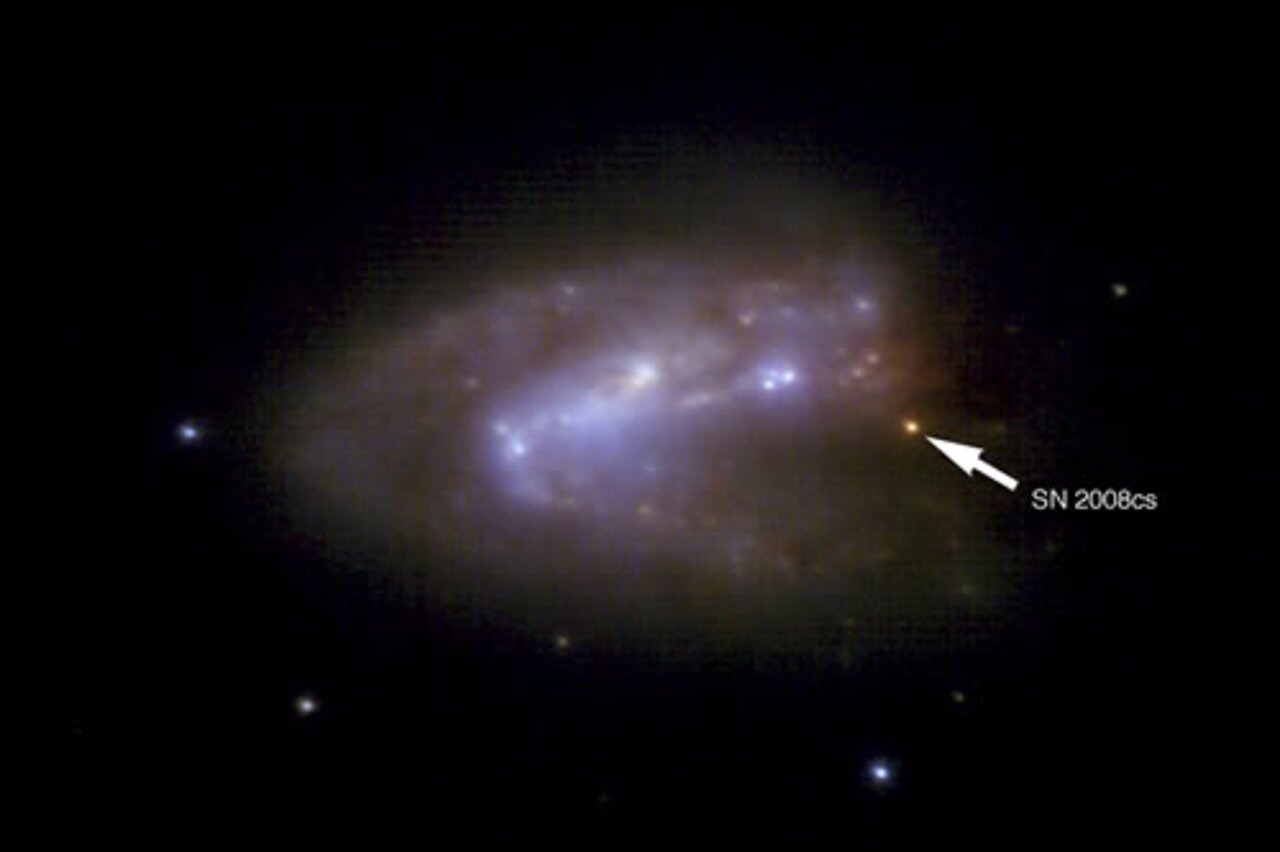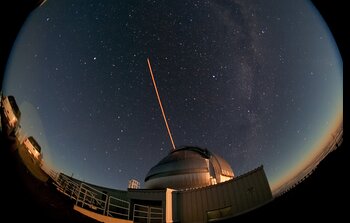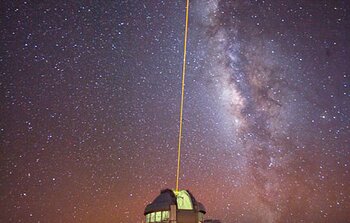First Supernova Discovered with Laser Guide Star Adaptive Optics
January 22, 2009

Stuart Ryder, Australian Gemini Scientist at the Anglo-Australian Observatory, and colleagues from Europe and South Africa have used the 8-meter Gemini North telescope in Hawai‘i and its laser guide star adaptive optics system to reveal a supernova (SN 2008cs) in a galaxy (IRAS 17138-1017) 250 million light-years away (Figure 1). This is the first supernova to be discovered using laser guide star adaptive optics. Along the way, the researchers also turned up a second, “historical” supernova, SN 2004iq, in the same galaxy.
Stellar evolution theory, along with the recent identifications of actual supernova progenitors, indicates that only stars more massive than ~8Msun will end their lives as core-collapse supernovae. Assuming that the ratio of such stars to less massive ones—the initial mass function—is the same everywhere in the universe, then the observed rate of supernovae can be used to gauge the rate of star formation, across a wide range of redshifts (or lookback time into the early universe).
However, the rate at which supernovae are discovered falls far short of the expected rate of events. Core-collapse supernovae ought to be occurring at the highest rates in galaxies undergoing a starburst episode since “starburst” galaxies are objects that have supernova progenitors being born in abundance.
The starburst galaxies known as Luminous Infrared Galaxies (LIRGs) and Ultra-Luminous Infrared Galaxies (ULIRGs), which emit total infrared luminosities in excess of 1011 and 1012 solar luminosities respectively, ought to be ideal places to find large numbers of such supernovae. And yet to date barely a handful of the 4,500 known supernovae have been found in such galaxies.
Both distance and dust make the task difficult. Most of the LIRGs are at least 150 million light-years away. And both LIRGs and ULIRGs are full of dust, which absorbs visible light and re-radiates it at the longer infrared wavelengths.
The large dust extinction, coupled with the tight concentration of star formation within the galaxy nuclear regions, makes it very challenging to spot even the brightest supernovae in such galaxies. Therefore infrared observations with high angular resolution are crucial for their detection.
Using Laser Guide Stars
In 2004 the research team, led by Seppo Mattila at the University of Turku in Finland, used the NAOS-CONICA adaptive optics system on ESO’s Very Large Telescope to discover a supernova, SN 2004ip, in the galaxy IRAS 18293-3413. This was the first supernova discovered using a natural guide star adaptive optics system.
Encouraged by this result, the team initiated a Gemini program, using Gemini North's laser guide star mode with the Altair adaptive optics system and the Near Infrared Imager (NIRI), to search for supernovae in LIRGs that don’t have a suitable natural guide star nearby. A set of nine LIRGS are being imaged at intervals of three to six months, over four observing semesters—a schedule that maximises the chance of supernova detection. The first detection came with just the third target observation, of the LIRG IRAS 17138-1017.
Comparing the Altair/NIRI image of April 2008 with an HST image made with the NICMOS infrared camera image in September 2004 revealed not one but two supernovae: what has now been named SN 2008cs in the 2008 image, and SN 2004iq in the 2004 image. A VLA detection of the radio counterpart of the object in the 2008 image confirmed that it was indeed a core-collapse supernova.
The inferred extinction towards SN 2008cs is about 18 magnitudes in the V-band, making it the most heavily extinguished supernova so far discovered. SN 2004iq is less obscured, having an extinction of less than 6 magnitudes in the V-band.
“Every supernova discovery takes us closer to the true star formation rate,” said University of Turku PhD student Erkki Kankare, the lead author of the paper: Kankare et al.. “Discovery of a Very Highly Extinguished Supernova in a Luminous Infrared Galaxy.” Astrophysical Journal Letters, 689:L97–L100, 2008 December 20.
Also see article in the December 2008 issue of GeminiFocus ppgs. 16-18.
In addition to Ryder, Mattila, and Kankare, the team is composed of J. Kotilainen (University of Turku); M.-A. Pérez-Torres, A. Alberdi, C. Romero-Canizales (Instituto de Astrofísica de Andalucia, CSIC); T. Díaz-Santos, A. Alonso-Herrero, L. Colina (Instituto de la Materia, CSIC); P. Väisänen (South African Astronomical Observatory); and A. Efstathiou (European University of Cyprus).


